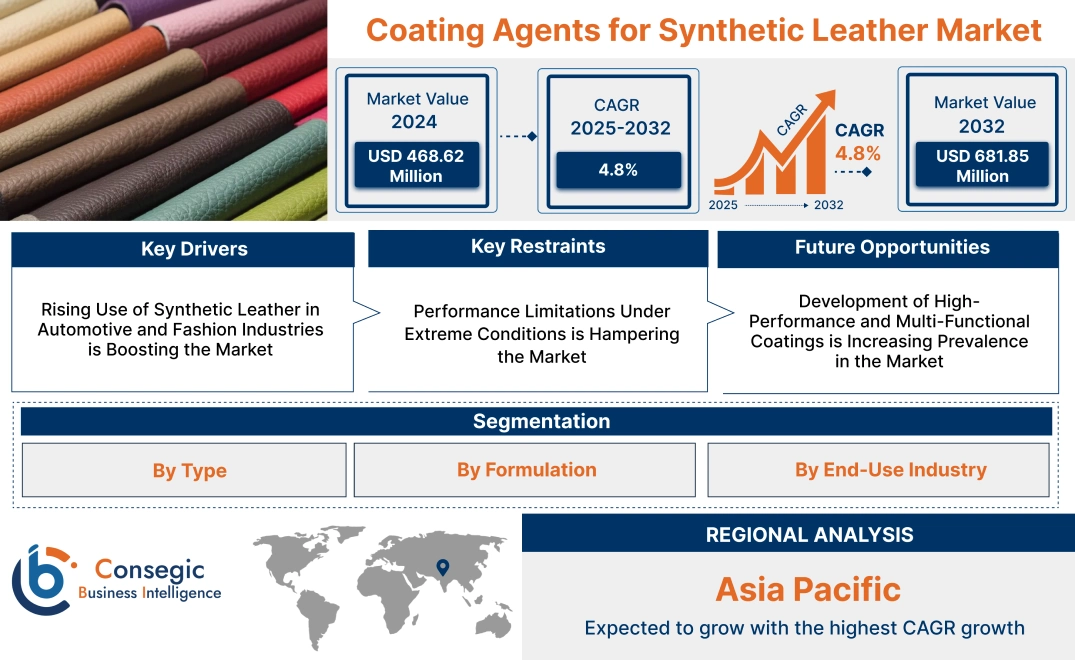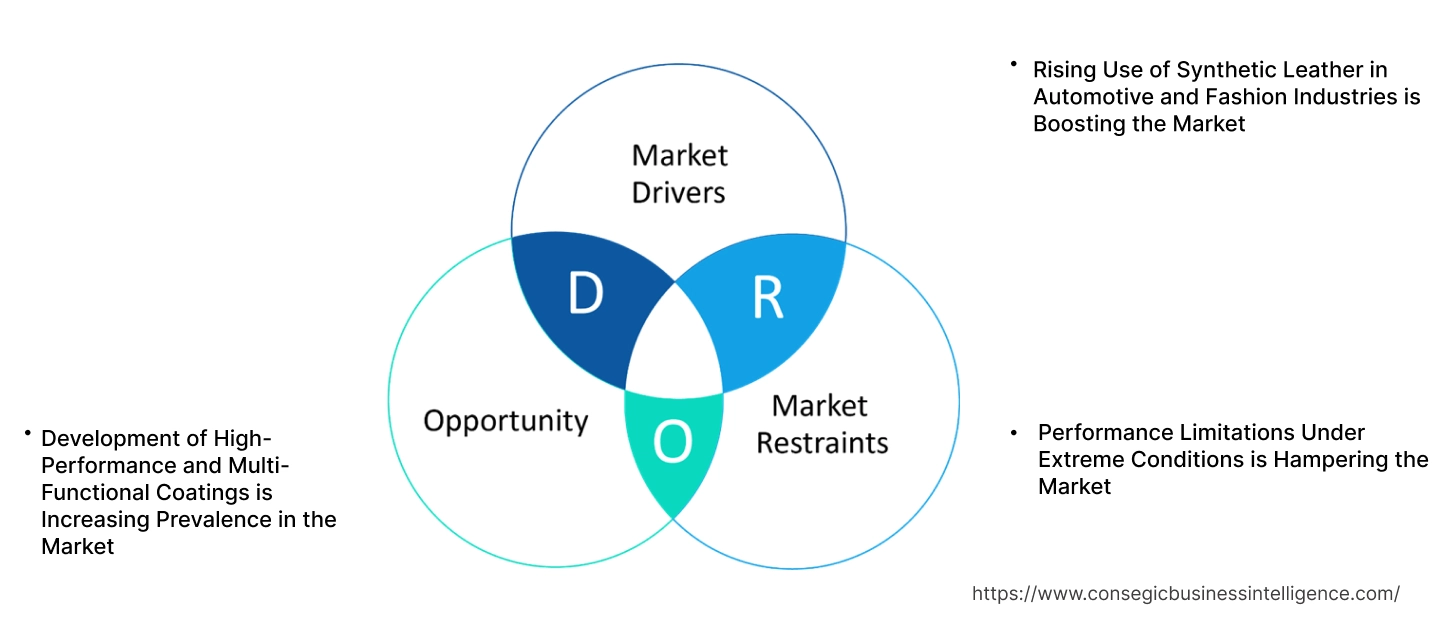- Summary
- Table Of Content
- Methodology
Coating Agents for Synthetic Leather Market Size:
Coating Agents for Synthetic Leather Market size is estimated to reach over USD 681.85 Million by 2032 from a value of USD 468.62 Million in 2024 and is projected to grow by USD 482.76 Million in 2025, growing at a CAGR of 4.8% from 2025 to 2032.
Coating Agents for Synthetic Leather Market Scope & Overview:
The coating agents for synthetic leather are specialized chemicals and formulations used to enhance the durability, aesthetics, and functionality of synthetic leather surfaces. These coating agents provide properties such as abrasion resistance, gloss, water repellency, and UV protection, ensuring long-lasting performance in diverse applications. Key characteristics of coating agents for synthetic leather include excellent adhesion, flexibility, and compatibility with various synthetic materials like polyurethane (PU) and polyvinyl chloride (PVC). The benefits include improved product lifespan, enhanced visual appeal, and greater resistance to environmental factors. Applications span automotive interiors, footwear, upholstery, fashion accessories, and sports equipment, where synthetic leather is a popular alternative to natural leather. End-users include automotive manufacturers, furniture producers, and fashion brands, driven by increasing trends for eco-friendly leather alternatives, advancements in synthetic leather manufacturing, and growing consumer preference for durable and sustainable products.
Key Drivers:
Rising Use of Synthetic Leather in Automotive and Fashion Industries is Boosting the Market
Synthetic leather has become a preferred alternative to genuine leather across the automotive and fashion industries due to its affordability, versatility, and reduced environmental impact. In automotive applications, synthetic leather is used for seat covers, dashboards, and door panels, providing durability and a premium aesthetic at a competitive cost. Similarly, in the fashion industry, synthetic leather has gained prominence for its ability to replicate the texture and appearance of genuine leather while offering design flexibility for products like shoes, bags, and apparel.
Trends in sustainable and cruelty-free materials have further amplified the adoption of synthetic leather, positioning coating agents as critical enhancers of its performance and appearance. These agents improve properties such as water resistance, UV protection, and abrasion resistance, ensuring that synthetic leather meets the stringent quality standards required in both industries. Analysis highlights that as consumer preferences lean toward eco-friendly and durable alternatives, the role of advanced coating agents in enhancing synthetic leather's appeal continues to grow.
Key Restraints:
Performance Limitations Under Extreme Conditions is Hampering the Market
While coating agents significantly enhance the performance of synthetic leather, certain formulations may exhibit limitations under extreme conditions such as high temperatures, prolonged UV exposure, or heavy mechanical stress. These performance challenges can lead to issues like color fading, surface cracking, or reduced flexibility, particularly in applications that demand long-term durability, such as automotive interiors and outdoor furniture.
Trends in advanced materials emphasize the need for coating agents that maintain performance even in harsh environments. However, addressing these limitations requires ongoing research and development to create formulations capable of withstanding extreme conditions without compromising aesthetics or functionality. Analysis suggests that overcoming these challenges is essential for expanding the usability of synthetic leather in demanding applications.
Future Opportunities :
Development of High-Performance and Multi-Functional Coatings is Increasing Prevalence in the Market
The development of high-performance and multi-functional coating agents presents a significant opportunity for the synthetic leather market. Innovations in material science have led to coatings that not only enhance durability and aesthetics but also offer additional functionalities such as anti-microbial properties, flame resistance, and improved tactile feel. These advancements cater to premium applications in sectors like luxury automotive, high-end furniture, and fashion, where superior quality is a critical requirement.
Trends in customization and value-added features are driving the advancement for multi-functional coatings that provide a competitive edge to synthetic leather products. Analysis indicates that manufacturers focusing on innovative formulations that align with sustainability goals and emerging consumer preferences are well-positioned to capture coating agents for synthetic leather market opportunities. By addressing both performance and environmental concerns, multi-functional coatings are paving the way for the next generation of synthetic leather solutions.
Coating Agents for Synthetic Leather Market Segmental Analysis :
By Type:
Based on type, the synthetic leather coating agents market is segmented into polyurethane (PU) coating agents, polyvinyl chloride (PVC) coating agents, acrylic coating agents, and others.
The polyurethane (PU) coating agents segment accounted for the largest revenue in coating agents for synthetic leather market share in 2024.
- Polyurethane (PU) coating agents are widely used in the synthetic leather sectors due to their excellent flexibility, durability, and aesthetic appeal.
- These coatings provide superior resistance to abrasion, moisture, and UV exposure, making them ideal for applications in automotive interiors, furniture, and fashion accessories.
- PU-coated synthetic leather is preferred for its resemblance to genuine leather, lightweight nature, and environmental advantages over PVC-based products.
- The rising coating agents for synthetic leather market trends for high-quality synthetic leather in premium automotive interiors and luxury furniture has significantly driven the adoption of PU coating agents.
The acrylic coating agents segment is anticipated to register the fastest CAGR during the forecast period.
- Acrylic coating agents are gaining traction due to their ability to provide a smooth surface finish, excellent adhesion, and high durability.
- These coatings are increasingly used in fashion accessories, footwear, and sports goods, where flexibility and weather resistance are critical.
- There is a growing coating agents for synthetic leather market demand for sustainable and cost-effective alternatives to traditional coating agents.
- Hence, along with advancements in acrylic formulations for improved performance, is expected to drive the rapid growth of this segment.
By Formulation:
Based on formulation, the synthetic leather coating agents market is segmented into acrylic, polyurethane, polyester, and epoxy.
The polyurethane formulation segment accounted for the largest revenue share in 2024.
- Polyurethane formulations dominate the market due to their exceptional versatility, offering high elasticity, toughness, and chemical resistance.
- These formulations are extensively used in the automotive, furniture, and fashion industries, where synthetic leather needs to endure frequent wear and tear.
- The ability of PU coatings to provide a wide range of finishes, from glossy to matte, and their compatibility with various synthetic leather substrates, has further bolstered their coating agents for synthetic leather market trends.
The epoxy formulation segment is anticipated to register the fastest CAGR during the forecast period.
- Epoxy formulations are increasingly adopted for their superior mechanical strength, adhesion, and resistance to environmental factors.
- These coatings are primarily used in sports goods and electronic applications, where durability and performance under harsh conditions are critical.
- The rising focus on advanced coating technologies and the need for durable synthetic leather in high-performance applications are expected to drive growth in this segment.
By End Use Industry:
Based on end-use industry, the synthetic leather coating agents market is segmented into automotive, furniture & upholstery, fashion & accessories, sports goods, electronics, and others.
The automotive segment accounted for the largest revenue of 26.70% in coating agents for synthetic leather market share in 2024.
- The automotive sectorrs is the largest consumer of synthetic leather coating agents, driven by the growing coating agents for synthetic leather market demand for lightweight and cost-effective alternatives to genuine leather in vehicle interiors.
- Coated synthetic leather is used extensively for seats, dashboards, and door panels, offering superior durability and aesthetic appeal.
- PU coating agents, in particular, are favored for their ability to provide luxurious finishes while maintaining resistance to wear and UV exposure.
- The increasing production of electric vehicles (EVs) and the rising trend of premium interior customization have further propelled the growth of this segment.
The fashion & accessories segment is anticipated to register the fastest CAGR during the forecast period.
- The fashion industry is witnessing rapid adoption of synthetic leather coating agents for the production of handbags, footwear, belts, and other accessories.
- Acrylic and PU coatings are particularly popular in this sector for their ability to deliver vibrant finishes, flexibility, and weather resistance.
- The growing preference for cruelty-free and sustainable materials among consumers has boosted the expansions for synthetic leather in fashion applications.
- Additionally, advancements in coating technologies for enhanced texture and durability are expected to drive significant coating agents for synthetic leather market growth in this segment.
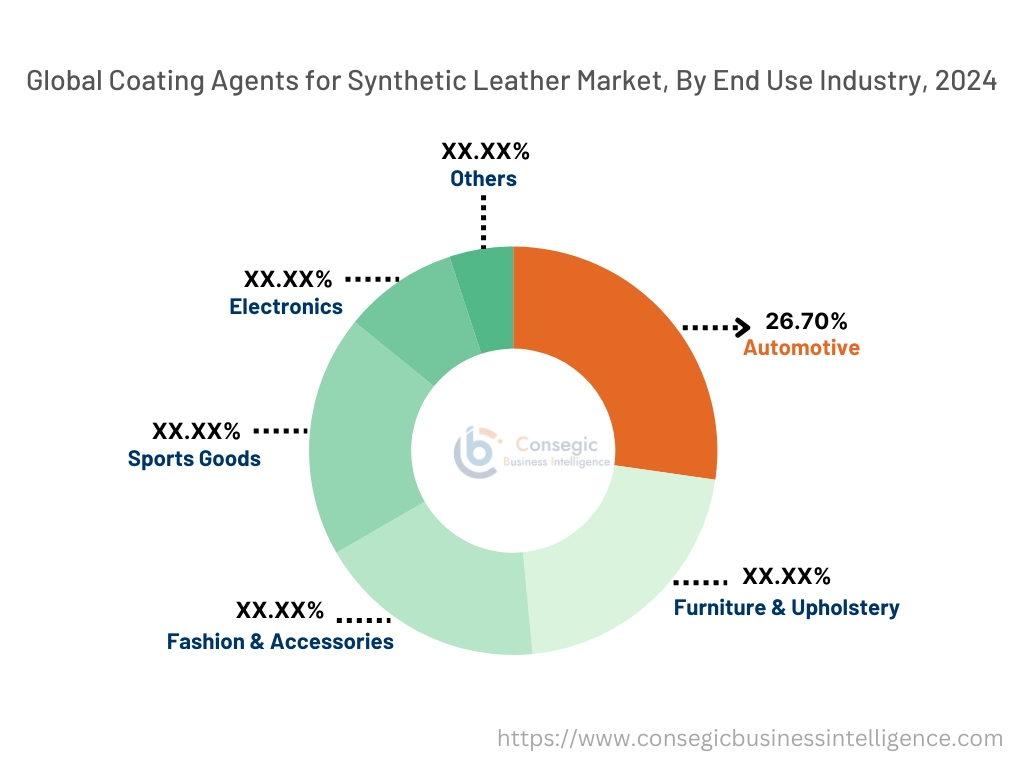
Regional Analysis:
The regions covered are North America, Europe, Asia Pacific, the Middle East and Africa, and Latin America.
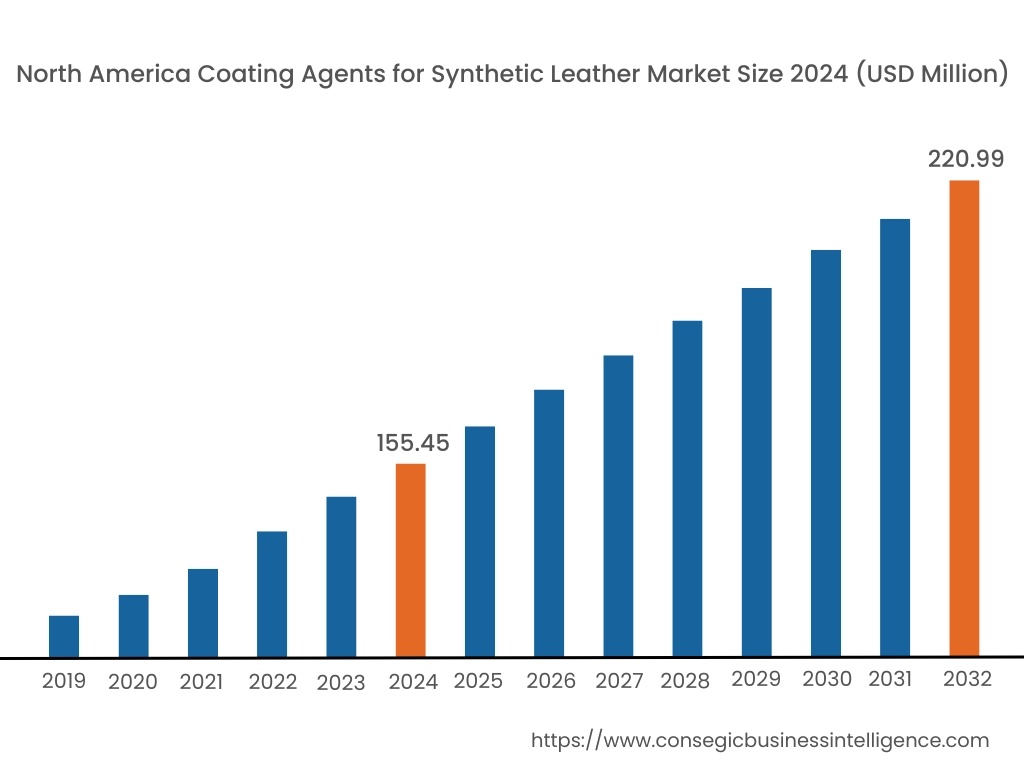
In 2024, North was valued at USD 155.45 Million and is expected to reach USD 220.99 Million in 2032. In North America, the U.S. accounted for the highest share of 70.80% during the base year of 2024. North America holds a significant share in the coating agents for synthetic leather market analysis, driven by increasing trends for durable and aesthetically pleasing alternatives to natural leather in industries such as automotive, fashion, and furniture. The U.S. leads the region, with a strong focus on environmentally friendly and high-performance coating agents that improve the durability and appearance of synthetic leather. Canada contributes with its growing use of synthetic leather in upholstery and footwear, supported by the rising awareness of cruelty-free and sustainable products. However, strict environmental regulations on volatile organic compounds (VOCs) in coatings may pose challenges for manufacturers.
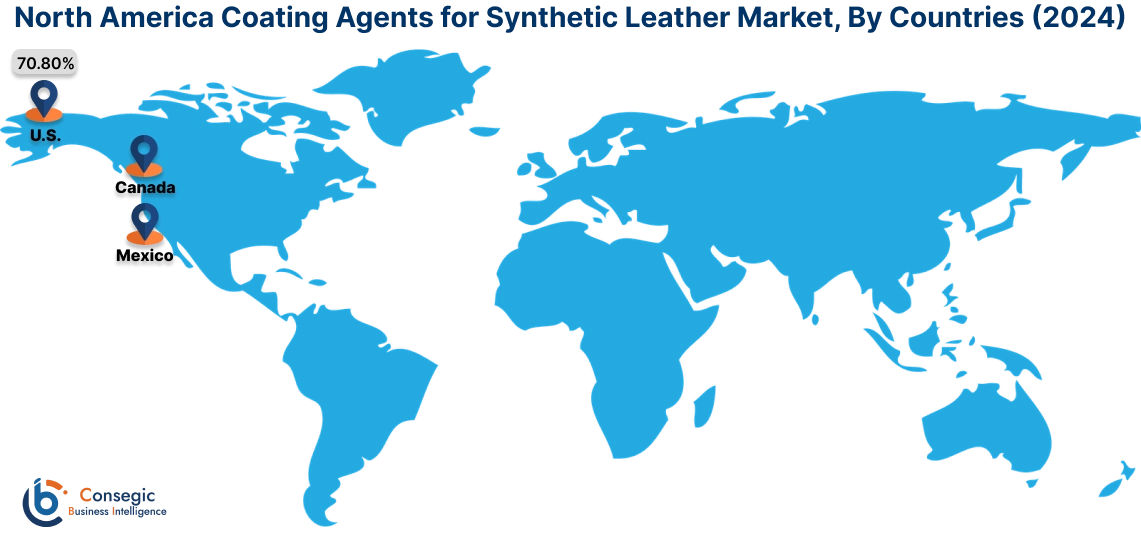
In Asia Pacific, the market is experiencing the fastest growth with a CAGR of 5.2% over the forecast period. In the coating agents for synthetic leather market analysis, fueled by rapid industrialization, urbanization, and growing consumer advancement for cost-effective alternatives to natural leather in China, India, and South Korea. China dominates the market with extensive use of synthetic leather in footwear, automotive, and fashion applications, driving trends for high-quality coating agents. India’s expanding automotive and furniture sectors further support the adoption of advanced coatings to enhance synthetic leather durability and aesthetics. South Korea emphasizes the use of innovative coating technologies in high-end consumer goods. However, fluctuating raw material prices and competition from low-cost alternatives may hinder coating agents for synthetic leather market growth in certain areas.
Europe is a prominent for global coating agents for synthetic leather market, supported by its well-established automotive, furniture, and fashion industries. Countries like Germany, Italy, and France are key contributors. Germany leads with high demand for advanced coating agents in automotive interiors, emphasizing durability and resistance to wear. As per the analysis Italy, known for its luxury goods sector, focuses on premium coating agents for synthetic leather used in fashion accessories and furniture. France emphasizes eco-friendly coating technologies to align with strict EU environmental standards. However, compliance with stringent regulations on chemical formulations and sustainability may increase production costs in the region.
The Middle East & Africa region is witnessing steady growth in the coating agents for synthetic leather market, driven by increasing trends for synthetic leather in furniture and automotive applications. Countries like Saudi Arabia and the UAE are adopting advanced coating technologies to enhance synthetic leather products used in luxury interiors and furniture. In Africa, South Africa is an emerging market, leveraging synthetic leather in the footwear and furniture industries, supported by growing consumer preferences for affordable and durable alternatives. However, limited local production capabilities and reliance on imports for advanced coatings may restrict market development in the region.
Latin America is an emerging market for coating agents for synthetic leather, with Brazil and Mexico leading the region. Brazil’s growing automotive and furniture industries drive demand for high-performance coating agents to improve synthetic leather quality and lifespan. Mexico emphasizes the use of synthetic leather in footwear and automotive interiors, supported by increasing investments in manufacturing technologies. The region is also exploring eco-friendly coating solutions to align with global sustainability trends. However, economic instability and inconsistent regulatory frameworks may pose challenges to coating agents for synthetic leather market expansion in some countries.
Top Key Players and Market Share Insights:
The coating agents for synthetic leather market is highly competitive with major players providing products to the national and international markets. Key players are adopting several strategies in research and development (R&D), product innovation, and end-user launches to hold a strong position in the coating agents for synthetic leather market. Key players in the coating agents for synthetic leather industry include -
- Stahl Holdings B.V. (Netherlands)
- LANXESS AG (Germany)
- Evonik Industries AG (Germany)
- Covestro AG (Germany)
- Elkem ASA (Norway)
- Wacker Chemie AG (Germany)
- R. Grace & Co. (USA)
- Lantan Technology Co., Ltd. (China)
- Abhilash Chemicals & Pharmaceuticals Pvt. Ltd. (India)
- CHT Germany GmbH (Germany)
Recent Industry Developments :
Advancements:
- In May 2024, the International Journal of Biological Macromolecules introduced an eco-friendly, phosphorus-free flame-retardant coating for microfiber synthetic leather. The coating is applied using alginate-based LbL assembly, enhancing flame resistance without compromising the material's mechanical properties.The treated synthetic leather exhibits improved flame retardancy, making it suitable for applications requiring stringent fire safety standards.
Coating Agents for Synthetic Leather Market Report Insights :
| Report Attributes | Report Details |
| Study Timeline | 2019-2032 |
| Market Size in 2032 | USD 681.85 Million |
| CAGR (2025-2032) | 4.8% |
| By Type |
|
| By Formulation |
|
| By End Use Industry |
|
| By Region |
|
| Key Players |
|
| North America | U.S. Canada Mexico |
| Europe | U.K. Germany France Spain Italy Russia Benelux Rest of Europe |
| APAC | China South Korea Japan India Australia ASEAN Rest of Asia-Pacific |
| Middle East and Africa | GCC Turkey South Africa Rest of MEA |
| LATAM | Brazil Argentina Chile Rest of LATAM |
| Report Coverage |
|
Key Questions Answered in the Report
What is the projected size of the Coating Agents for Synthetic Leather Market by 2032? +
Coating Agents for Synthetic Leather Market size is estimated to reach over USD 681.85 Million by 2032 from a value of USD 468.62 Million in 2024 and is projected to grow by USD 482.76 Million in 2025, growing at a CAGR of 4.8% from 2025 to 2032.
What are the key drivers for market growth? +
The market is driven by the rising adoption of synthetic leather in the automotive and fashion industries due to its affordability, versatility, and eco-friendly nature.
What challenges does the market face? +
Performance limitations of certain coating formulations under extreme conditions, such as prolonged UV exposure or high temperatures, present a challenge. These limitations can affect durability and flexibility, particularly in applications like automotive interiors and outdoor furniture.
Which type of coating agent holds the largest market share, and why? +
Polyurethane (PU) coating agents hold the largest market share due to their flexibility, durability, and ability to provide high aesthetic appeal. PU coatings are widely used in automotive interiors, furniture, and fashion accessories because of their resemblance to genuine leather and superior performance characteristics.
